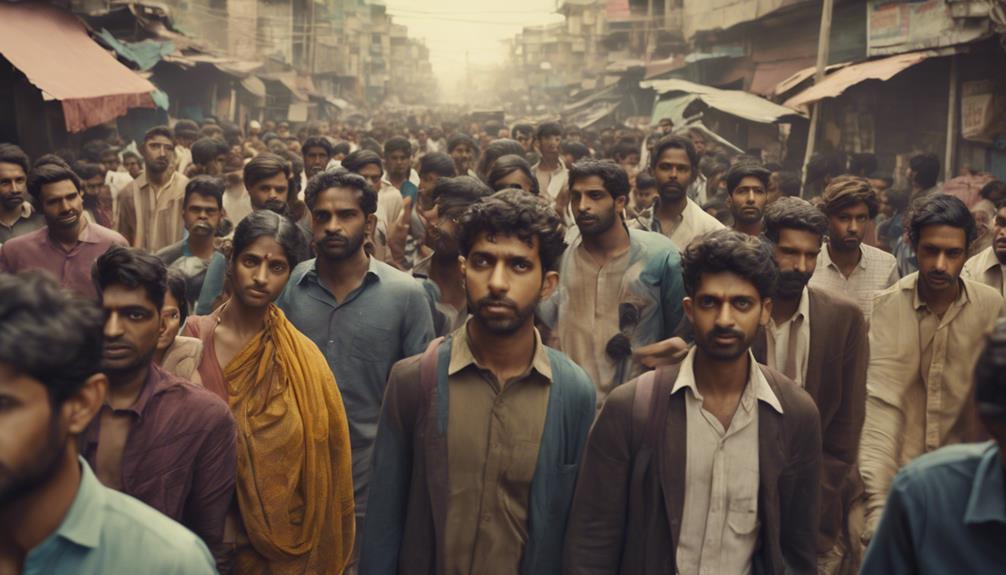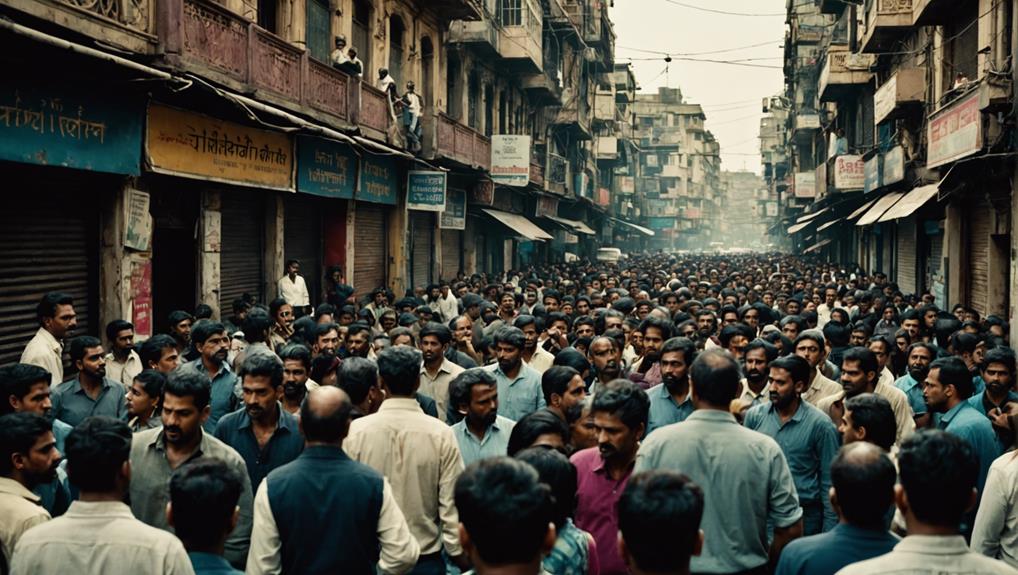Embark on a journey through the intricate tapestry of emotions in 'A Fine Balance' by Rohinton Mistry. Explore themes like survival, friendship, and societal upheaval, all woven into a delicate balance of hope and despair. Witness the characters' evolution through power struggles and resilience. Unravel the symbolism of the Sewing Machine and the Monsoon, adding layers to the narrative. The socio-political climate and historical backdrop provide a rich context for exploring injustice and human resilience. Immerse yourself in the multiperspective narrative structure and literary techniques that enhance the storytelling. Your exploration promises deeper insights into this poignant tale.
Key Themes Explored
Exploring key themes in 'A Fine Balance reveals the profound impact of struggles for survival, friendship, family dynamics, and societal upheaval on individuals' lives. Within the delicate balance of hope and despair that permeates the novel, the search for identity stands out as a pivotal theme.
As characters navigate through the challenges of their circumstances, they grapple with the ever-present tension between hope for a better future and the despair brought on by their harsh realities.
The theme of balance is intricately woven into the fabric of the narrative, highlighting the characters' constant effort to maintain equilibrium in the face of adversity. This effort mirrors the intricate dance between hope and despair that shapes their decisions and actions throughout the story.
As they work to find a sense of stability amidst chaos, the characters' journeys reflect the universal quest for balance in the midst of life's uncertainties.
Character Dynamics Analysis
In 'A Fine Balance', the character dynamics analysis sheds light on the intricate relationships and power struggles that unfold among Dina Dalal, Ishvar and Omprakash Darji, Maneck Kohlah, and the Beggar Master, revealing the complexities within the societal fabric they navigate.
Dina Dalal's resilience and independence contrast with Ishvar and Omprakash Darji's bond, showcasing the strength found in human connection amidst caste discrimination and adversity.
Maneck Kohlah's innocence and idealism serve as a poignant reminder of the harsh realities surrounding him, emphasizing the fragile balance between hope and despair.
The Beggar Master's complex power dynamics highlight the intricate struggles and alliances within the societal hierarchy, illustrating the impact of relationships on individual paths.
Through these characters, 'A Fine Balance' explores the intricate web of human connections, portraying both the fragility and strength that arise when individuals navigate the challenging socio-political landscape.
Impact of Socio-Political Climate

You'll explore how the political turmoil in 'A Fine Balance' intertwines with themes of social injustice, shedding light on the oppressive environment characters navigate.
The historical backdrop plays a significant role in shaping the narrative, offering a stark portrayal of the challenges faced during the Emergency period in India.
Through Mistry's storytelling, you'll witness how the socio-political climate impacts the lives and relationships of the characters, highlighting the harsh realities of that tumultuous era.
Political Turmoil in Novel
The novel 'A Fine Balance' by Rohinton Mistry vividly portrays the impact of the socio-political climate in mid-1970s India, particularly during the state of Emergency, where characters grapple with the sinister presence of Prime Minister Indira Gandhi and the repercussions of her policies.
Characters like Dina, an independent woman trying to maintain her tailoring business, are deeply affected by the unstable economic system and political turmoil. The narrative explores the harsh realities faced by individuals during this tumultuous period, where forced sterilizations and political repression disrupt the lives of ordinary citizens.
Through Mistry's storytelling, the reader witnesses the detention, torture, and societal upheaval experienced by the characters, providing a stark portrayal of the challenges they endure. The author skillfully captures the atmosphere of India under the Emergency, shedding light on the struggles and injustices prevalent in a time of intense political upheaval.
'A Fine Balance' serves as a poignant reminder of the human rights violations and social injustices that marred the era, leaving a lasting impact on its characters and readers alike.
Social Injustice Themes
Characters in 'A Fine Balance' navigate through the socio-political climate of 1970s India, facing the harsh realities of social injustice manifested in detention, torture, forced sterilization, and political unrest. Rohinton Mistry's portrayal of the Mistrys and other characters in the novel brings to light the deep-rooted issues of the caste system and its impact on society.
The Mistrys, like many others, experience discrimination and oppression due to their social status, illustrating the pervasive nature of social injustice during that time. Through their struggles, readers witness the detrimental effects of societal structures that perpetuate inequality and marginalize certain communities.
The novel serves as a poignant reminder of the challenges faced by individuals caught in the web of political decisions and societal norms that dictate their fate. By delving into these themes, Mistry effectively captures the harsh realities of social injustice and sheds light on the plight of marginalized groups in a tumultuous socio-political climate.
Historical Backdrop Significance
Amidst the backdrop of political turmoil and societal upheaval in 1970s India, 'A Fine Balance' by Rohinton Mistry vividly captures the harsh realities faced by its characters. Set during the Emergency period in India, Mistry's narrative explores the impact of Indira Gandhi's authoritarian regime on the lives of ordinary individuals.
The novel portrays the atmosphere of fear and uncertainty that prevailed during this tumultuous time, highlighting themes of detention, torture, and forced sterilization imposed by the government.
The presence of political unrest in 'A Fine Balance' reflects the significant nature of power dynamics under the Emergency, showcasing how political decisions can profoundly affect individuals' lives and relationships. Mistry skillfully uses the socio-political landscape of India during this period as an essential backdrop to explore the characters' struggles and the broader themes of resilience, survival, and human spirit amidst adversity.
Through his storytelling, Mistry sheds light on the harsh realities faced by his characters, providing a poignant commentary on the impact of the socio-political climate on society.
Symbolism and Imagery
Symbolism and imagery in 'A Fine Balance' intricately weave themes of empowerment and societal constraints, offering readers a nuanced understanding of the characters' journeys.
The Sewing Machine symbolizes independence and empowerment for the characters, illustrating their resilience in the face of adversity. Through this symbol, Rohinton Mistry highlights the characters' ability to carve out their path despite societal limitations.
The Monsoon serves as a powerful symbol of destruction and renewal, mirroring the characters' experiences of turmoil and hope in the novel.
Additionally, the imagery of the Flat represents the societal norms and constraints that the characters must navigate, emphasizing the challenges they encounter in pursuing autonomy.
Mistry's adept use of symbolism and imagery enhances the emotional impact and thematic depth of 'A Fine Balance', allowing readers to explore further into the characters' struggles and triumphs.
Literary Techniques Unpacked

You'll explore how symbolism in writing adds layers of meaning. Character development analysis deepens your understanding of the protagonists' journeys. A breakdown of the narrative structure enhances your appreciation of the storytelling in 'A Fine Balance'.
These aspects of literary techniques will offer insights into how Rohinton Mistry crafts his compelling narrative, enriching your reading experience and understanding of the novel's complexities.
Get ready to unravel the intricacies of Mistry's writing through these critical lenses.
Symbolism in Writing
Occasionally, authors incorporate symbolism in their writing to convey deeper meanings and enhance the overall narrative experience. In 'A Fine Balance' by Rohinton Mistry, the Sewing Machine serves as a powerful symbol throughout the novel. It represents economic empowerment and self-sufficiency for the characters, reflecting their aspirations and struggles in a society marked by inequality and hardship.
The Sewing Machine becomes a metaphor for the characters' hopes for a better future and their determination to overcome adversity through hard work and perseverance.
Mistry's adept use of symbolism, including the Sewing Machine, adds layers of complexity to the story, inviting readers to explore the underlying themes of independence, resilience, and the human spirit. By infusing his narrative with symbolic elements, Mistry deepens the reader's understanding of the characters' experiences and the broader societal issues at play.
Through the Sewing Machine and other symbols, Mistry masterfully crafts a tale that resonates with profound insights into the human condition and the complexities of life.
Character Development Analysis
Character development in 'A Fine Balance' unfolds intricately through the skilled use of multiperspective narration. Rohinton Mistry employs literary devices such as symbolism, irony, and foreshadowing to enrich the growth of Dina, Ishvar, Om, and Maneck. Through their interactions and responses to various situations, the characters evolve, showcasing their resilience and adaptability.
The novel's tone, which oscillates between moments of levity and instances of tragedy, plays a pivotal role in shaping the arcs of these characters. Mistry's adept use of allegory and pathos not only deepens the narrative but also serves as a critique of societal norms, fostering empathy for the characters' hardships.
As readers explore further into the story, they witness the profound transformation of each character, culminating in a profound exploration of the human experience through the lens of adversity and perseverance.
Narrative Structure Breakdown
Skillfully employing a multiperspective narrative structure, Rohinton Mistry intricately weaves together various literary techniques in 'A Fine Balance.' In Mistry's novel, the narrative structure breakdown unfolds in a compelling manner:
- Multiperspective Narrative: Through the viewpoints of the main characters, Mistry offers a detailed look at the interconnected lives of Dina, Maneck, Ishvar, and Om.
- Symbolism: The use of symbolic elements like the sewing machine and the monkey man adds depth and layers to the story, enriching the reader's experience.
- Irony and Foreshadowing: Mistry masterfully utilizes irony and foreshadowing to create tension and anticipation, keeping readers engaged throughout the novel.
- Flashbacks: By incorporating flashbacks, Mistry provides insight into the characters' pasts, helping readers understand their motivations and actions in the present.
These narrative techniques not only enhance the storytelling but also contribute to the immersive and emotionally resonant experience of 'A Fine Balance.'
Resilience and Hope Themes
Amidst the challenges faced by characters in 'A Fine Balance' by Rohinton Mistry, resilience and hope shine as guiding beacons, illuminating their paths through the turbulent landscape of 1970s India.
Mistry intricately weaves a narrative that showcases characters like Dina, Ishvar, Om, and Maneck confronting adversity with unwavering courage and determination. Despite the harsh realities they encounter, these characters find moments of hope and inner strength that propel them forward.
Through their interwoven stories, Mistry underscores a profound message of resilience in the face of despair and the remarkable ability of the human spirit to triumph over hardship.
The themes of resilience and hope in 'A Fine Balance' not only resonate deeply with readers but also serve as a poignant reminder of the resilience inherent in individuals, offering a powerful reflection on the capacity to endure and discover light even in the darkest of times.
Final Thoughts and Reflections

In the closing pages of 'A Fine Balance,' readers are left with a profound sense of introspection and contemplation. As you reflect on the intricate web of relationships and struggles depicted in the novel, here are some final thoughts and reflections to ponder:
- The delicate Fine Balance between hope and despair is a central theme that resonates long after the final pages. How do you find equilibrium in your own life when faced with adversity?
- The novel's portrayal of resilience serves as a reminder that even in the darkest times, there's always a glimmer of hope. How can you nurture resilience in the face of challenges?
- Confronting the harsh realities of poverty and oppression through the characters' experiences, 'A Fine Balance' prompts readers to ponder the impact of societal injustices on individual lives. How can you contribute to creating a more just world?
- The enduring power of human spirit and the importance of empathy and solidarity are beautifully woven throughout the narrative. How can you practice empathy and solidarity in your interactions with others?
As you navigate through the complexities of 'A Fine Balance,' may these reflections inspire you to seek hope and work towards a more compassionate world.
Conclusion
As you navigate through 'A Fine Balance' by Rohinton Mistry, remember that life is like a box of chocolates – you never know what you're gonna get.
The key themes, character dynamics, socio-political impact, symbolism, and literary techniques all come together to create a rich tapestry of resilience and hope.
So keep turning the pages and delving deeper into the intricate web of emotions and experiences that Mistry has masterfully crafted.
Happy reading!



